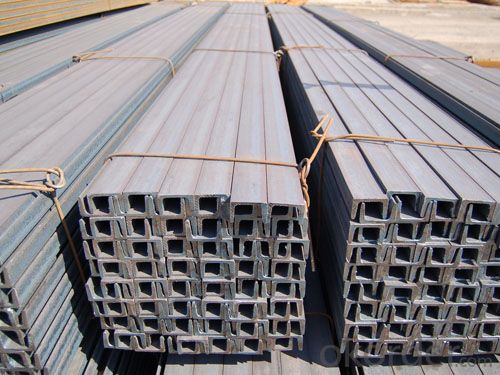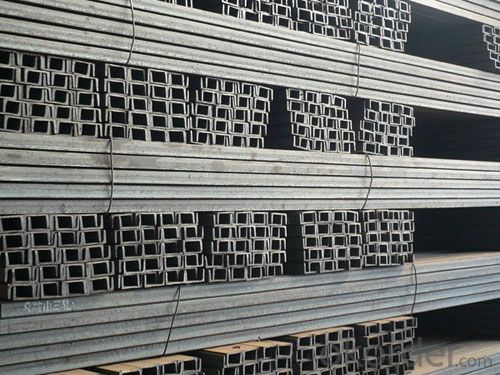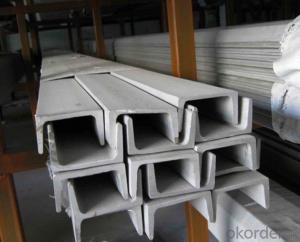Steel JIS U Channel Hot Rolled High Quality
- Loading Port:
- Tianjin
- Payment Terms:
- TT OR LC
- Min Order Qty:
- 25 m.t.
- Supply Capability:
- 20000000 m.t./month
OKorder Service Pledge
OKorder Financial Service
You Might Also Like
Item specifice
Product Description:
OKorder is offering Steel JIS U Channel Hot Rolled High Quality at great prices with worldwide shipping. Our supplier is a world-class manufacturer of steel, with our products utilized the world over. OKorder annually supplies products to European, North American and Asian markets. We provide quotations within 24 hours of receiving an inquiry and guarantee competitive prices.
Product Applications:
According to the needs of different structures, Angle can compose to different force support component, and also can be the connections between components. It is widely used in various building structures and engineering structures such as roof beams, bridges, transmission towers, hoisting machinery and transport machinery, ships, industrial furnaces, reaction tower, container frame and warehouse etc
Product Advantages:
OKorder's Steel Steel JIS U Channel Hot Rolled High Quality are durable, strong, and resist corrosion.
Main Product Features:
· Premium quality
· Prompt delivery & seaworthy packing (30 days after receiving deposit)
· Corrosion resistance
· Can be recycled and reused
· Mill test certification
· Professional Service
· Competitive pricing
Product Specifications:
Manufacture: Hot rolled
Grade: Q195 – 235
Certificates: ISO, SGS, BV, CIQ
Length: 6m – 12m, as per customer request
Packaging: Export packing, nude packing, bundled
Sizes: 25mm-250mm | ||||||||||||
a*t | ||||||||||||
25*2.5-4.0 | 70*6.0-9.0 | 130*9.0-15 | ||||||||||
30*2.5-6.6 | 75*6.0-9.0 | 140*10-14 | ||||||||||
36*3.0-5.0 | 80*5.0-10 | 150*10-20 | ||||||||||
38*2.3-6.0 | 90*7.0-10 | 160*10-16 | ||||||||||
40*3.0-5.0 | 100*6.0-12 | 175*12-15 | ||||||||||
45*4.0-6.0 | 110*8.0-10 | 180*12-18 | ||||||||||
50*4.0-6.0 | 120*6.0-15 | 200*14-25 | ||||||||||
60*4.0-8.0 | 125*8.0-14 | 250*25 | ||||||||||
FAQ:
Q1: What makes stainless steel stainless?
A1: Stainless steel must contain at least 10.5 % chromium. It is this element that reacts with the oxygen in the air to form a complex chrome-oxide surface layer that is invisible but strong enough to prevent further oxygen from "staining" (rusting) the surface. Higher levels of chromium and the addition of other alloying elements such as nickel and molybdenum enhance this surface layer and improve the corrosion resistance of the stainless material.
Q2: Can stainless steel rust?
A2: Stainless does not "rust" as you think of regular steel rusting with a red oxide on the surface that flakes off. If you see red rust it is probably due to some iron particles that have contaminated the surface of the stainless steel and it is these iron particles that are rusting. Look at the source of the rusting and see if you can remove it from the surface.
Q3: How do you package the angle steel when shipping?
A3: All goods are packed in bundles with steel strips and shipped by container or break bulk.



- Q:How do steel channels contribute to the overall durability of a building?
- Steel channels contribute to the overall durability of a building in several ways. Firstly, they provide structural support by distributing the load evenly across different parts of the building, ensuring stability and preventing deformation. Additionally, steel channels have high tensile strength, allowing them to withstand heavy loads and forces, such as those caused by wind or earthquakes. They also enhance the building's resistance to corrosion and fire due to their non-combustible nature and protective coatings. Overall, steel channels significantly enhance the longevity and safety of a building, making it more durable and robust.
- Q:How do steel channels contribute to the stability of crane runways?
- The stability of crane runways is enhanced by steel channels in multiple ways. Firstly, these channels provide a robust and rigid support structure for the crane to operate on. Typically constructed from high-quality steel, known for its durability and ability to bear heavy loads, they ensure that the crane runway can withstand the weight and dynamic loads imposed during operation. In addition, steel channels are designed to evenly distribute the load across the supporting beams or columns. This prevents concentrated stress points and spreads the load over a larger area, reducing the risk of structural failure or collapse. By effectively distributing the load, steel channels maintain the stability of the crane runway, even when subjected to heavy loads or sudden movements. Another significant role of steel channels in crane runways is their capacity to withstand lateral forces. These forces may arise from wind, uneven loading, or sudden changes in direction as the crane moves along the runway. Steel channels provide a strong framework that effectively resists these lateral forces, preventing excessive deflection or sway in the runway structure. This is vital for maintaining the stability and safety of the crane during operation. Furthermore, steel channels are easily fabricated and installed, allowing for efficient construction of crane runways. They can be customized to meet the specific requirements of the crane and the site, ensuring a precise fit and optimal performance. The versatility of steel channels also allows for various configurations and layouts, making it possible to design crane runways that can accommodate different crane sizes and load capacities. In conclusion, steel channels play a crucial role in ensuring the stability of crane runways. Their strength, load-bearing capacity, and ability to distribute loads evenly contribute to the overall structural integrity of the runway. Additionally, their resistance to lateral forces and ease of installation make them an excellent choice for constructing reliable and safe crane runways.
- Q:Can steel channels be used for architectural purposes?
- Yes, steel channels can be used for architectural purposes. Steel channels are versatile and can be utilized in many architectural applications such as the construction of building frames, support structures, and architectural facades. They provide strength and stability to the overall structure, making them ideal for architectural projects where durability and load-bearing capacity are important considerations. Steel channels also offer flexibility in design as they can be easily fabricated and customized to meet specific architectural requirements. Moreover, their sleek and modern appearance can enhance the aesthetic appeal of a building, making them a popular choice among architects and designers. Overall, steel channels are a reliable and practical option for architectural purposes.
- Q:What is the load-bearing capacity of steel channels?
- The load-bearing capacity of steel channels depends on various factors such as the size and shape of the channel, the grade and quality of the steel used, and the specific application and conditions in which it is being used. Steel channels are commonly used in construction and engineering projects to provide support and structural stability. They are designed to withstand the weight and pressure exerted on them without deforming or collapsing. To determine the load-bearing capacity of a steel channel, engineers typically consider the maximum allowable stress or load that the channel can safely carry without exceeding its yield strength or causing permanent deformation. This is usually determined through rigorous testing and analysis, taking into account the specific properties and dimensions of the channel. It is important to note that load-bearing capacity can vary significantly depending on the specific design and manufacturing processes used for the steel channel. Therefore, it is crucial to consult engineering specifications, codes, and standards, or seek the guidance of a professional engineer to accurately determine the load-bearing capacity of a specific steel channel for a given application.
- Q:Industrial plant pipe hanger expansion bolts, why add a section of channel, and then connect the screw rod?. The outer expansion bolt of the embedded beam is connected with a section of channel steel, and then the steel bar is hung under the channel steel. Why do you want to do this? What are the advantages?
- Outside the first expansion bolt connected with a section of steel, steel hanging wire hanger form following bar is now commonly used in the expansion and harness
- Q:Can steel channels be used for shelving systems?
- Indeed, shelving systems can utilize steel channels. By virtue of their strength and durability, steel channels prove to be well-suited for bearing substantial loads. Their ability to be effortlessly affixed to walls or alternative structures yields a stable and robust shelving system. Moreover, the assortment of sizes and lengths in which steel channels are available permits customization to cater to distinct storage requirements. On the whole, owing to their vigor and adaptability, steel channels are widely favored for shelving systems in warehouses, garages, and various industrial environments.
- Q:Is the channel 20 the same as the channel 20b?
- No, channel 20, a and B two.20A specifications are: 200*73*7.0, weight per meter is 22.637kg20b specifications are: 200*75*9.0, weight per meter is 25.777kg
- Q:What are the different methods of strengthening steel channels against bending?
- To enhance the resistance of steel channels against bending, there are multiple approaches that can be employed: 1. Augmenting the cross-sectional area of the channel: One effective way to strengthen a steel channel is by increasing its cross-sectional area. This can be accomplished by utilizing a thicker channel or incorporating supplementary steel plates or sections to expand the overall area. 2. Employing reinforcement plates or stiffeners: By attaching reinforcement plates or stiffeners to the weak points of the channel, its ability to withstand bending can be significantly improved. These plates or stiffeners are typically welded to the channel and aid in distributing the applied loads more uniformly, thus reducing the risk of bending. 3. Introducing flanges or lips: Another viable method involves adding flanges or lips to the edges of the channel. These supplementary steel sections enhance the rigidity of the channel, rendering it more resistant to bending. 4. Implementing bracing or truss systems: Bracing or truss systems can be utilized to provide support to the steel channel and prevent bending. These systems consist of additional steel members, such as braces or trusses, that are connected to the channel to offer extra support and distribute the applied loads. 5. Utilizing heat treatment: Heat treatment techniques like quenching and tempering can be employed to fortify the steel channel. These processes involve heating the channel to a specific temperature and then rapidly cooling it to increase its hardness and strength. 6. Employing cold working techniques: Cold working techniques like cold rolling or cold drawing can also be used to strengthen steel channels against bending. These processes involve shaping the channel at low temperatures, thereby enhancing its strength and toughness. It is important to note that the choice of method depends on various factors, including the specific application, the desired level of strength, and the available resources and equipment. It is advisable to consult with a structural engineer or steel fabrication expert to determine the most suitable method for strengthening steel channels against bending in a particular situation.
- Q:What are the different types of steel channel connections for column framing?
- There are several types of steel channel connections used for column framing, including welded connections, bolted connections, and pinned connections. Welded connections involve welding the steel channels together to create a strong and rigid joint. Bolted connections use bolts and nuts to secure the channels together, allowing for easier assembly and disassembly. Pinned connections utilize pins or dowels to connect the channels, providing flexibility and allowing for relative movement between the connected members.
- Q:I have three houses, the length is 7 meters, the width is 4 meters, I would like to use a 4 meter trough board to do the support, and then put concrete slabs on the channel, the two floor of the roof also do so, can I do that? If it is possible to use a large trough plate, a thick concrete slab, and a thick steel bar for concrete slabs Thank you
- The concrete of channel steel is made of concrete and steel bar. This kind of floor has the advantages of firmness, durability, rigidity, high strength and good fire resistance, and is widely used at present. According to the construction method, it can be divided into two major categories: cast-in-place reinforced concrete floor and prefabricated reinforced concrete floor.
1. Manufacturer Overview |
|
|---|---|
| Location | |
| Year Established | |
| Annual Output Value | |
| Main Markets | |
| Company Certifications | |
2. Manufacturer Certificates |
|
|---|---|
| a) Certification Name | |
| Range | |
| Reference | |
| Validity Period | |
3. Manufacturer Capability |
|
|---|---|
| a)Trade Capacity | |
| Nearest Port | |
| Export Percentage | |
| No.of Employees in Trade Department | |
| Language Spoken: | |
| b)Factory Information | |
| Factory Size: | |
| No. of Production Lines | |
| Contract Manufacturing | |
| Product Price Range | |
Send your message to us
Steel JIS U Channel Hot Rolled High Quality
- Loading Port:
- Tianjin
- Payment Terms:
- TT OR LC
- Min Order Qty:
- 25 m.t.
- Supply Capability:
- 20000000 m.t./month
OKorder Service Pledge
OKorder Financial Service
Similar products
New products
Hot products
Related keywords




























